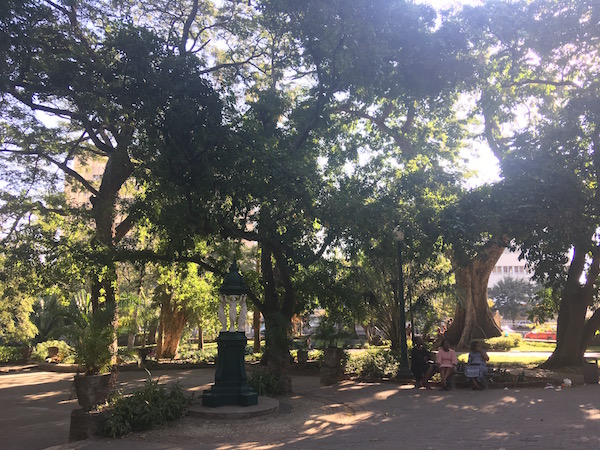
My trip from New York to Mozambique back in July consisted of a 15-hour overnight flight to Johannesburg, a six-hour layover, and another hour-long flight to Maputo. Suffice it to say I was non-functional upon arrival. I got to the hotel on Saturday evening, was sound asleep in bed by 8pm, woke up late the next morning, had a leisurely breakfast, and only then re-emerged into the world of the living to figure out what this new city and country was all about.
It turns out that Sundays in Maputo are exceedingly pleasant. The city was really quiet and calm, and many of the wide boulevards were empty of both people and cars.
I had mapped out some hastily-compiled recommendations from the internet, and I set out on a walking tour to see as many of them as I could.

My first stop was the Teachers Garden, which featured a crafts market, a playground, and the beautiful Acacia Cafe overlooking Maputo Bay. Truly an oasis of tranquility, and a very international spot that seemed to be popular with ex-pats and Mozambicans alike.

From there it was a short walk to the Natural History Museum, which is in a stunning building but is sort of outdated inside.


I was in and out within fifteen minutes and headed west, towards downtown. I ran straight into the botanical gardens, which is more like a very nice city park than a repository of fancy flowering things.


From there I walked south towards the docks, until I hit the fortress just off the bay.

Apparently Maputo was frequently attacked by Austrian, French, Dutch, and British forces so the fortress was built by the Portuguese in the 18th century to protect their colonial interests.

Across the square from the fort is one of the oldest buildings in Maputo, and the home of the National Museum of Numismatics i.e. currency.

The beautifully-appointed building houses coins and paper money from around the world and across time periods.



A few blocks west of the museum is the old railway station, inaugurated in 1910 (and completed in 1916), which is the most stunning structure I saw in Maputo. (But I’m a sucker for old railway stations.)


Other beautiful and/or interesting buildings seen in the vicinity:





The big municipal market is above. I never got a chance to go inside as it was closed on Sunday .

Above is the Casa de Ferro, designed by Eiffel and built in 1892. It was meant to be the governor’s residence, but the iron-plated exterior made it so hot on the inside that no one could actually live or work in it until air conditioning was invented and installed. That’s what I call lack of forethought.

Above, the French-Mozambican Cultural Center, which is just a few doors down from the Iron House.
They are both just south of Independence Plaza, off of which sit City Hall,…

… a striking-looking church,…

…and a statue of Samora Machel, the first President of Mozambique after the country became independent in 1975.

It was nearing sunset by the time I got there, so I returned to the hotel, and the next day I flew north for work. I didn’t get back to Maputo until late the next Saturday. That Sunday I went to Maputo Special Reserve, which I will show you in a different post. The following week, from Monday until Friday, I worked days in the Maputo office of my company, went to a new place for dinner every night, and tried to see a little bit more of the city whenever I could steal a few moments for myself. Here are some highlights:
The artisans’ market, which draws crowds on weekends not only to stroll the vendors’ booths but also to watch the live music and hang out at the open air cafes.


The esplanade, which was beautiful all up and down the long length I walked.


Below, a block from my office, the leafy park / playground / cafe complex where I went several times for lunch and most mornings for espresso.

The mysterious gutted villa a block from my hotel, below.

And food standouts:
Bom Garfo, a Brazilian-style steakhouse that was recommended to me by a colleague. I had been trying to limit my meat intake, but I probably hit my quota for the whole year here. I won’t post a pic because it would just be a plate piled high with meat and that is not the most attractive thing in the world.
At Txhapo Txhapo, I also rather inadvertently ordered a meat-heavy plate, and it was the best thing I ate in all of Mozambique. In fact it was so delicious that I came back to the restaurant the next day (and ordered another meat-heavy plate, oopsie). If you go to Maputo, hit this restaurant. It’s very vegetarian-friendly, too, including but not limited to an extensive fresh smoothie selection. Dishes one and two are below.


Next up will be northern Mozambique, specifically Tete Province, where I went for work but incidentally saw a ton of beautiful and interesting things (in addition to my beautiful and interesting work).

So, Ruth, when you say “a block from my office” on this post, does that mean you were working there?
Your pal, Don
Hey, Don! I work in NYC but we have country offices in West Africa, East Africa, and Southeast Asia. Sometimes I’m lucky enough to get to take trips to the field and work out of those offices for a week or two. Your pal, Ruth